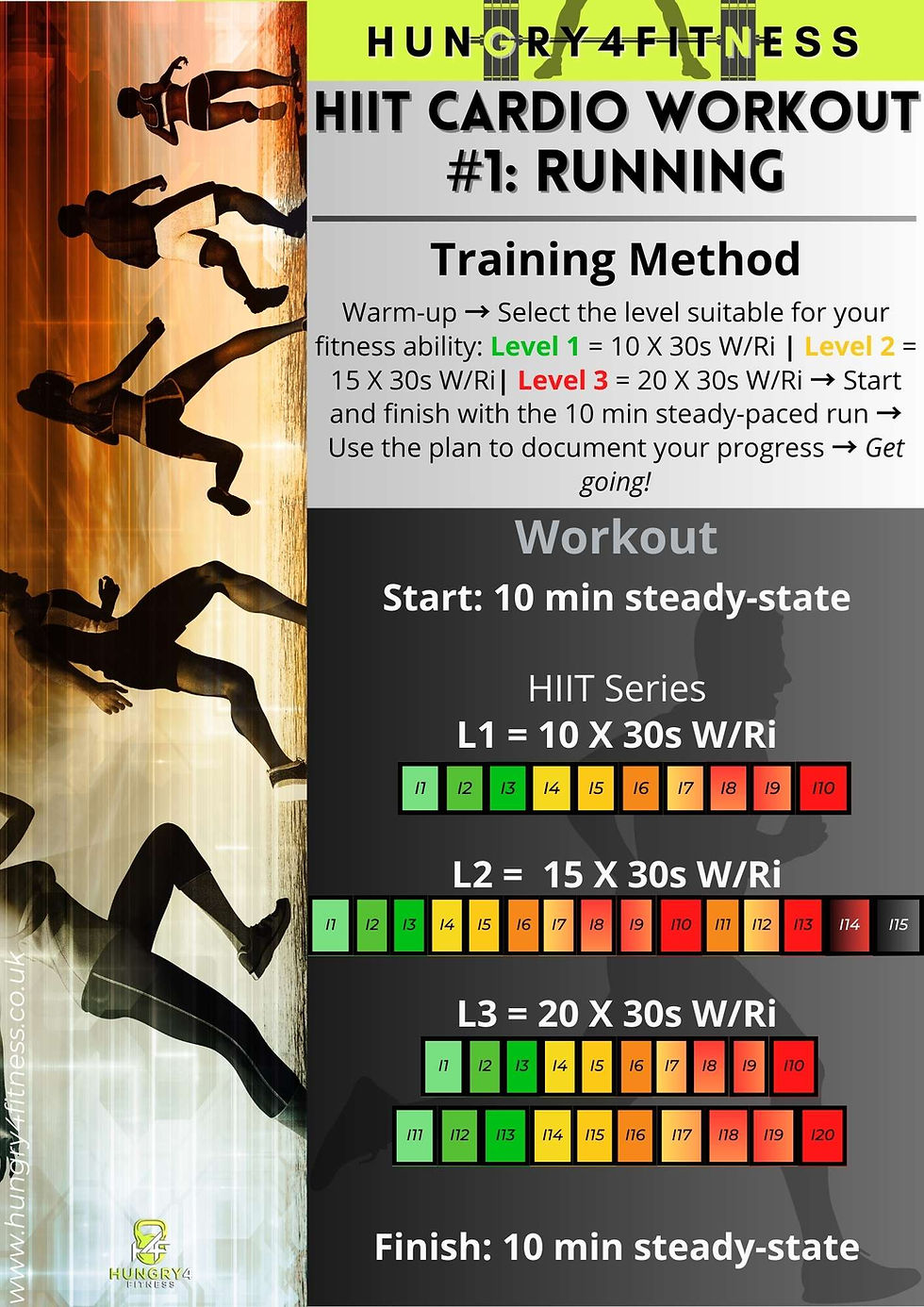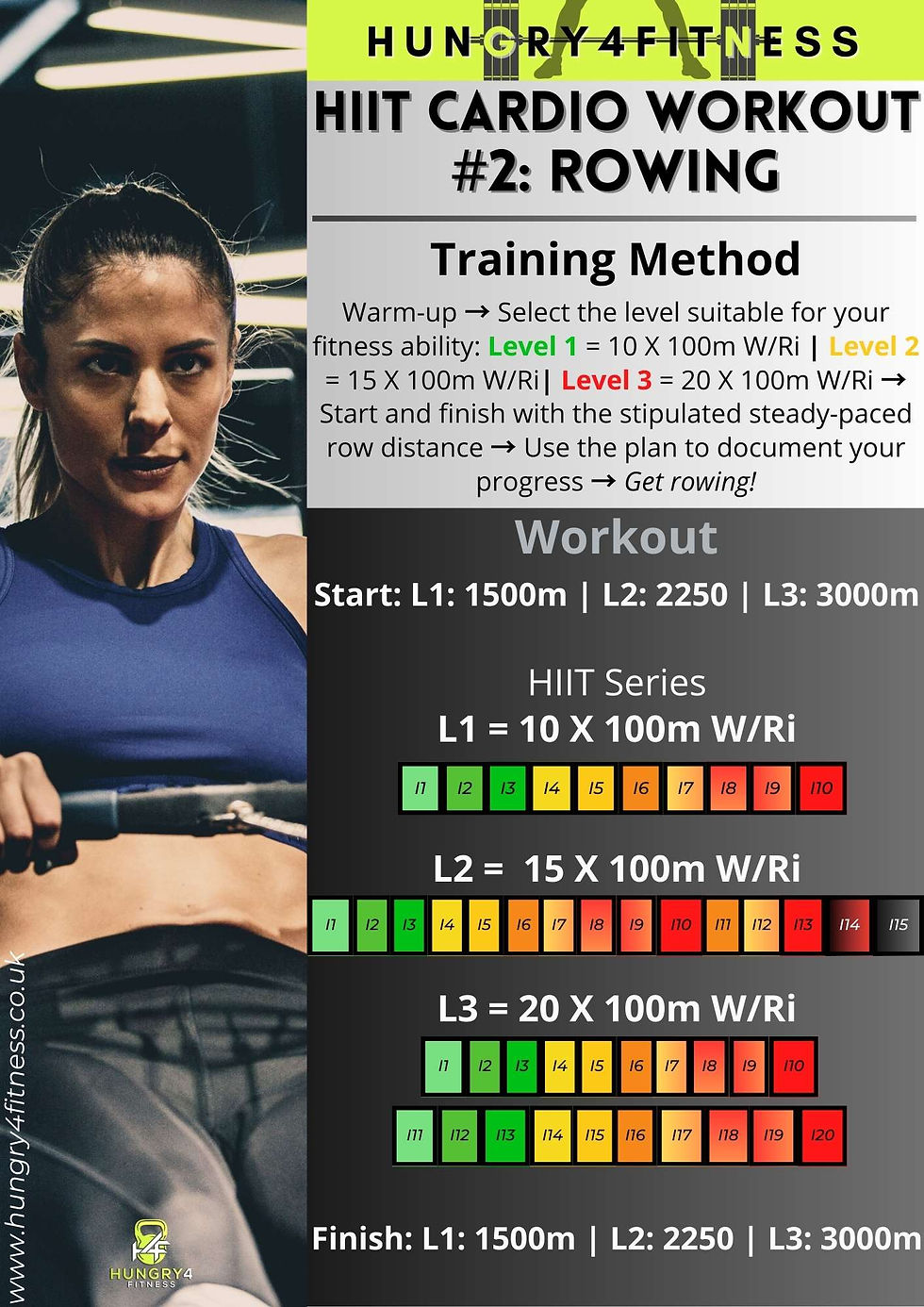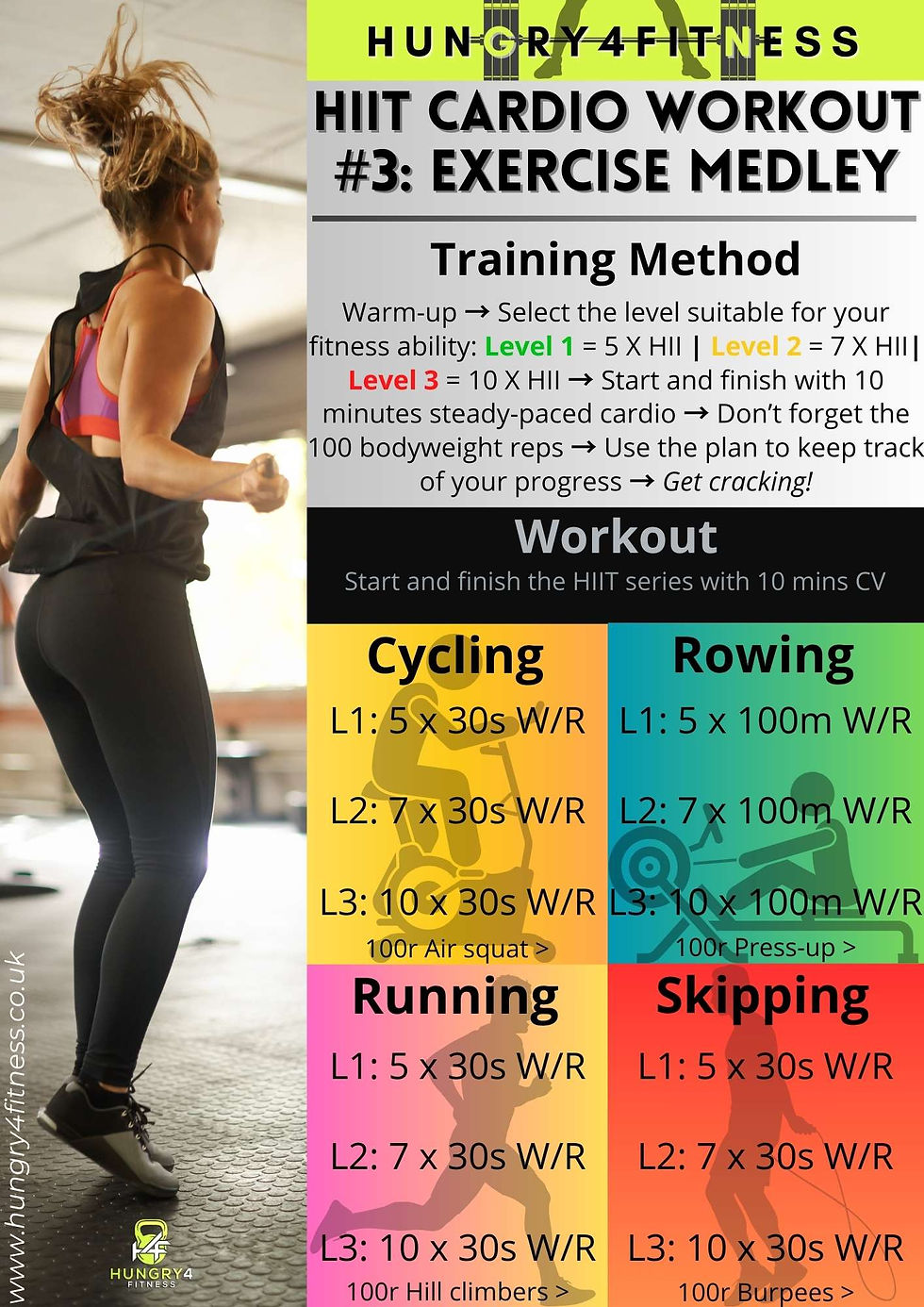Trim, Tone, And Tune With These HIIT Cardio Workouts
- Hungry4Fitness
- Feb 17, 2024
- 9 min read

This site contains product affiliate links. We may receive a small commission if you make a purchase after clicking on one of these links.
If your routine has gone cold and you’re looking to turn up the heat, these three HIIT cardio workouts are for you. The mixture of exercises and easily modifiable plans make the workouts suitable for any training facility. You can take them to the gym, include them in your morning routine, or squeeze one into a lunch break.
But you might be thinking how can I cram a sweat session into a 30-minutes? Well, as I explain in a little more detail below, each plan can be tailored to suit your training needs. If you’re not up for the full HIIT cardio experience, say you want to cap your resistance routine with a 10-minute pulse raiser, the workouts can be trimmed to fit this requirement.
And don’t think that a 10-minute HIIT cardio workout can’t possibly confer any health or fitness benefits. Below, if you want to stick around for a bit, we’ll explore a spot of research showing that HIIT bouts as short as 7 minutes can promote the same physiological responses as a 30-minute steady-state run.
HIIT cardio workouts benefits
It’s long been known that HIIT enhances aerobic and anaerobic conditioning (Physiology of Exercise). For decades now athletes have been tapping into high-intensity interval training as an effective method of increasing performance. HIIT was popularised in the 1920s by multi-Olympic gold medal runner Paavo Nurmi who incorporated short high-intense bursts into his routine.
But how does HIIT help improve our fitness?
Professor Daniel Liberman answers this question in his excellent book Exercised: The Science of Physical Activity, Rest & Health. Drawing off a score of recent research, Liberman confirms that, ‘Because HIIT stresses the cardiovascular system more acutely than moderate-intensity aerobic exercise, it can yield rapid, dramatic benefits.’
These benefits, in case you’re wondering, include ‘substantially’ elevating cardio fitness, ‘bringing down blood pressure,’ lowering ‘harmful cholesterol levels’ and burning harmful organ fat (Exercised).
That’s not the end of the story. In addition to the benefits listed above, Liberman adds two more. Regularly participating in HIIT cardio workouts has also been shown to ‘improve muscle function; and ‘stimulate the production of growth factors [BDNF1] that can protect the brain.’
Related: Try out these Gym Cardio Workouts >
HIIT Cardio dosage
You’re probably thinking that to bag all those impressive benefits you’ll have to start training like an Olympic athlete. Thankfully, this is not the case.
Many of the physiological adaptations outlined above – improved cardio, lowered blood pressure, fat loss, enhanced muscle function – were identified in participants who were prescribed six HIIT sessions a week.
Wait, six sessions a week? That sounds like a lot!
It does, but not when we realise that one session involved just six 30-second maximal repetitions followed by a rest. Yep, you read that right. Those health and fitness benefits were brought about by a mere three minutes of HIIT performed six times a week over the course of a couple of months.
On reviewing the study, Liberman concluded that ‘Astonishingly, HIIT had as much or more effect on the [participants’] cardiovascular fitness and metabolism’ than those ‘who did more conventional long term aerobic training.’
Related: Discover more Health & Fitness Benefits of HIIT
HIIT cardio workouts #1: Running
Our first HIIT cardio workout is right out of the textbook. Thus, it’ll suit the purists in the audience. It observes what Willmore and associates call a ‘precise training prescription’ of the ‘systematic manipulation of exercise and relief intervals,’ (Exercise Physiology). Put more simply, there is a sequence of 30-second high-intensity intervals which are balanced by a rest period of equal duration.
To cater to varying levels of fitness ability, the workout has been organised into three levels of difficulty. The protocol (30 sec work / 30 sec rest) remains the same across the levels. All that distinguishes them is the number of bouts.
Level 1 = 10 intervals
Level 2 = 15 intervals
Level 3 = 20 intervals
Before you enter the intervals, you’ll complete a 10-minute steady-paced run at around 50% of max effort.
Concerning session plan adaptations. There are loads of ways that you can modify the tasks to suit your training preferences. For example, depending on time constraints, you could reduce the initial run and focus on the intervals. Alternatively, you have the option of retaining the structure of the plan but trimming the timings – say, a 5-minute run followed by 10, 15, or 20 intervals of 20 seconds. In short, don’t worry about tailoring the plan to suit your needs.
Key points
Spend between 5- and 10 minutes warming up. Suggested warm-up: 1 min mobility exercises (joint flexions and rotations) → 1000m run (build pace over distance) → 5 x 30-sec work/rest intervals (start at 50% HRmax and increase by 10% with each interval) → Start the workout!
Before traversing the intervals, complete the 10-minute run. Sustain a consistent pace of about 50% of your aerobic threshold (or perceived maximum effort). (This can be used as an extended warm-up should you find yourself short on time.)
Tackle the intervals. Your objective is to sustain 80% to 95% of mx effort.

HIIT cardio workouts #2: Rowing
Along with cycling, rowing is one of the best CV exercises for applying HIIT. The responsivity of the machine enables us to manipulate the intensity (almost) instantaneously. To raise the work rate from 50% of max effort to 100% takes two huge heaves. Bringing it back down takes even less. These factors allow us to maintain a precise protocol which reduces blurring between the work/rest boundary. That is to say, we can sustain near-maximal output for the full interval duration.
That’s all well and good but what about the workout?
It observes a similar structure to its predecessor. After a steady-state protracted row, you will proceed to progress through a series of high-intensity intervals. The minor distinguishing difference is that the interval length is governed by distance as opposed to time. Instead of sustaining output for 30 seconds – as with workout 1 – you’ll be doing so for 100 metres (the rest is the same length).
The HIIT series concludes with another steady-paced row. You have three difficulty levels to choose from. They are:
Level 1 = 1500m (@ 50% max effort)
10 x 100 intervals (each followed by a reduced-intensity active recovery row of equal distance) → 1500m (@ 50% max effort). Total distance: 5000 metres.
Level 2 = 2250m (@ 50% max effort)
15 x 100 intervals (each followed by a reduced-intensity active recovery row of equal distance) → 2250m (@ 50% max effort). Total distance: 7500 metres.
Level 1 = 3000m (@ 50% max effort)
20 x 100 intervals (each followed by a reduced-intensity active recovery row of equal distance) → 3000m (@ 50% max effort). Total distance: 10,000 metres.
Key points
Complete the warm-up provided (or try this all-purpose gym warm-up): 1 min mobility exercises (joint flexions and rotations) → 1000m rowing (low to medium intensity) → 5 x 100m work/rest intervals (start at 50% HRmax and increase by 10% with each interval) → Start the workout!
Select the level commensurate with your fitness ability. (It’s perfectly acceptable to mix and match the levels. For example, you could sandwich the L2 or L3 HIIT series between the L1 pre and post-steady-state distance – or vice versa.)
Aim for 50% of max effort for the steady-state distances and, if possible, the reduced-intensity recovery periods.
Of course, while the objective is to flog yourself silly during the high-intensity intervals, make sure to maintain composure.

HIIT cardio workouts #3: Medley
Our final cardio HIIT workout is not nearly as pernickety as the previous two. To appeal to a wider audience (because up to this point what’s there for you if you don’t much like running or rowing?) and diversify the training outcomes, four cardio exercises comprise the plan. And if that wasn’t nuts enough, I’ve shaken things up by interspersing the cardio stations with bodyweight exercises.
Granted, all this funny business would send a HIIT purist’s heart rate throughout the roof. But that’s a risk I’m willing to take to bring you a workout that is more physically (and mentally) stimulating. Here’s an outline of the method.
The plan is kicked into touch with 10 minutes of steady-state cardio. Nothing new there. Following the extended warm-up, you’ll transition to the first station – cycling – but not before deciding on the appropriate difficulty level.
Concluding station one, complete the bodyweight reps – the number is dedicated to the HIIT difficulty previously selected. Repeat this process until you’ve circumnavigated all four stations. Finish with a final 10-minute reduced-intensity bout of CV then hit the shower.
Key points
Complete this 10-minute warm-up: 1 min mobility exercises (joint flexions and rotations) → 2 min cardio (40% HRmax) → 30 secs air squats → 2 min cardio (50% HRmax) → 30 secs press-ups → 2 min cardio (60% HRmax) → 30 secs squat thrusts → 2 min cardio (70% HRmax) → 30 secs burpees → Start the workout!
Select the level commensurate with your fitness ability. (It’s perfectly acceptable to mix and match the levels. For example, you could sandwich the L2 or L3 HIIT series between the L1 pre and post-steady-state distance – or vice versa.)
Aim for 50% of max effort for the steady-state distances and, if possible, the reduced-intensity recovery periods.

HIIT CV workouts hints and tips
HIIT cardio workout #1: This workout is far easier to facilitate outdoors. If you’ve got access to a sports field or athletics track, you can HIIT until your heart’s content. However, if you don’t have such a luxury, and your only flat patch of terra firma is a treadmill, conducting a HIIT workout can be problematic. The primary reason is that treadmills are not as responsive to intensity modulations (unlike rowers or stationary bikes!). On a track at resting, you can reach maximum intensity in two strides (think of a 100-metre sprinter out of the blocks). To reach a comparable speed on the treadmill from resting will take around 30 seconds – by which time the interval will have elapsed. How do you overcome this HIIT-impeding time lag?
The only technique is to set the belt at your desired high-intensity speed and, using the treadmill supports, lower yourself on and off the belt. But this is an advanced technique that comes accompanied by a grisly gang of health and safety risks – which I need not elaborate on. An alternative method – not ideal but much safer – is to maintain a belt speed of 50% of maximal intensity between intervals. As your interval initiation point approaches, you will begin increasing the speed. The interval countdown would only begin once max intensity had been reached. This method is physically more demanding than the first for the simple reason that you are not fully recovering between intervals. Thus, if applying the second method, it would be permissible to take longer rest periods.
HIIT cardio workout #2: The issues outlined above are not a concern when performing HIIT on an indoor rower. The ergo machine not only boasts exceptional responsivity, but it also provides instant feedback on your performance. Thus, if you know your target HIIT pace (say 1:35/500), you can ‘dial’ into it quicker than a teenager can type a text message. So, what’s the tip?
Related: Best Rower for the Home Gym >
Along the length of the row stroke – from catch to full extension – there is what I call the ‘power zone’ (or, to jump on the abbreviation bandwagon, 'PZ' for short). The PZ is the stroke segment where we’re able to apply maximal force. It is sandwiched between the weakest points – catch and full extension – and it is where we want to remain during each high-intensity interval. In addition to confining the stroke length to the PZ, we also ought to raise our strokes per minute (SPM). To make this a lot less complicated, I’ve endeavoured to encapsulate my explanation in a table. See below:
Row work/rest interval splits

HIIT cardio workout #3: Nailing a successful medley is a matter of orchestrating transition proficiency (and tracking progress). While the session plan is more involved, and has many moving parts, it comes with the cost of an increase in complexity. Unlike workouts 1 and 2, where you can lapse into a cognitive catatonic-like state (or full-blown unconsciousness if you’re savvy enough to set audible interval alerts on your training timer), you must keep mentally engaged during the medley. If you don’t you run the risk of missing stations or overshooting the interval prescription. This final tip can be distilled into a simple advisory sentence: use the session plan provided.
Ready for these Fartlek Workouts?
Enjoyed these workouts?
Get your hands on 80 more with the Hungry4Fitness Book of Circuits & Workouts Volume 3 >
About Adam Priest –
A former Royal Marines Commando, Adam Priest is a content writer, college lecturer, and health and fitness coach. He is also a fitness author and contributor to other websites. Connect with Adam at info@hungry4fitness.co.uk.
_p.png)

Comments